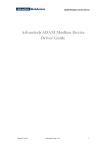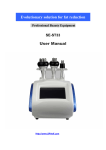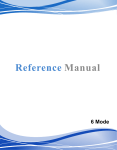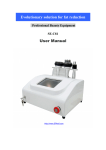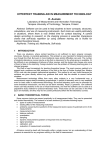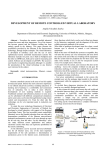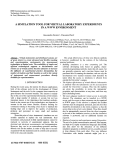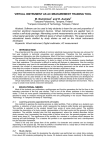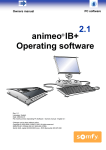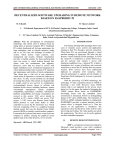Download Industrial Water Level Measurement and Control System Based on
Transcript
11th IMEKO TC-4 Symp. - Trends in Electrical Measurement and Instrumentation - September 13-14, 2001 - Lisbon, Portugal INDUSTRIAL WATER LEVEL MEASUREMENT AND CONTROL SYSTEM BASED ON VIRTUAL INSTRUMENT TECHNOLOGY Tianshu Huang(IEEE member)(1), Zheng Zhang(2) ,Qingzhen Ren(3), Jidong Xiang(4) (1) (2) (3) (4) Department of Electronic Information, Wuhan University, Wuhan, 430072, P.R.China Tel: 86-27-67803897, Fax: 86-27-67803410, e-mail: [email protected] Department of Electronic Information, Wuhan University, Wuhan, 430072, P.R.China Tel: 86-27-67803896, Fax: 86-27-67802125, e-mail: [email protected] Department of Electronic Information, Wuhan University, Wuhan, 430072, P.R.China Tel: 86-27-67803897, Fax: 86-27-67803410, e-mail: [email protected] Department of Electronic Information, Wuhan University, Wuhan, 430072, P.R.China Tel: 86-27-67803896, Fax: 86-27-67802125, e-mail: [email protected] Abstract This paper discusses the design and implementation of a new industrial water level measurement and control system. Virtual Instrument technology is employed to construct the software and hardware framework. The modularized system features high flexibility and expandability. The system provides with parameter display, data testing, alarming, storage and printing. The system is opening and compatible. Fig.1 is the system constructed with virtual instrument technology. It is used for measuring temperature, pressure, flux and signal of valves. PLC communicates with the upper host computer in series communication. Host PC Printer Keywords - Virtual instrument, communication, water level, control ADAM 5510 ADAM 5510 1. INTRODUCTION Temp. Flux Pressure Valve Temp. Flux Fig.1 System Construction System uses virtual instrument graphics programmable software ---- LabVIEW. Based on virtual instrument technology, system may be described as following, (1) Instrument Module: It is hardware level and is directly faced to object. It is the base of water level control system. It implements functions of data acquisition, adjustable control etc. Input message of ADAM5510 module is faced to transducers’ signals, such as flux, pressure and water level etc. Instrument Interface: RS-232 is used to implement communication between ADAM5510 and host PC. I/O interface software: I/O interface is a series of canonical and programmed functions in advance, which has been provided by software developer. LabVIEW uses a kind of standard application program I/O programmable interface (API) named VISA to implement the communication. VISA is a high-level API. LabVIEW provided many ready-made VISA for application. 2. SYSTEM STRUCTURE DESIGN ADAM5510 is programmable aptitude controller that can be used in data acquisition and control. it has four I/O modules (64 channels), provides a serial port (RS-232/485) to communicate with other devices. ADAM5510 may directly connect many kinds of transducers to measure temperature, pressure, flux etc. The input may be standard industrial voltage, current or various digital signals. It is suitable in water level measurement and control system. ISBN 972-98115-4-7 © 2001 IT Pressure Valve With the development of DCS, field bus technology etc, automation measurement and control systems are applied widely in a variety of industry fields. Water level measurement and control system is a typical application. Recent years virtual instrument system has got noticeable development. It is a great breakthrough for conventional instrument technology. The virtual instrument is a result that computer combines with instrument technology. It breaks through the restriction of traditional instrument in data processing, display, storage etc, which makes it easier for users in maintenance, expanding, and upgrading their instrument systems. By utilizing latest computer technology, virtual instrument technology makes it easier to realize and expand the functions of the conventional instrument. This paper designs a real-time and automatic M&C (measure and control) system based on the virtual instrument technology. The system is opening and compatible. 145 two characters specifies the module channel and slot. Based on the command, an optional data segment may follow the command string. An optional two bit checksum character may also be appended to the command string. Every command is terminated with a carriage return. Because the LabVIEW doesn’t support the ADAM5510 driver, user has to develop the communication program between ADAM5510 and LabVIEW. So he must be clear of the interior address distribution of ADAM5510 system, which is a little difficult to a developer. In this paper, an easy method is introduced. It is available to imitate the ADAM5000/485 in programming the communication drivers because LabVIEW supports the driver of ADAM5000/485. Thus, sending and receiving of commands may be done in the command format of ADAM5000/485. ADAM5510 receives the commands then unscramble them, carries out corresponding functions of ADAM5510. In the end it sends the result to the PC in the way of ADAM5000 in order to implement the control and data collection. For example, change the ADAM5000 into ADAM5510 without changing other configuration. When LabVIEW needs to acquire the data from the module ADAM5017, LabVIEW sends ‘#01S1’ to ADAM5510 and the user’s programs in it judges the sent command to see if received command corresponding with instruction set of ADAM5000/485 (like ‘#01S1(CR)’). If it is true, then it returns an answer in the format of command( > 1.4567 +1.4852 +1.6661 +1.6321 +1.6459 +2.989 +1.7768 +1.1623 CR ) and LabVIEW accepts the ADAM5510 as ADAM 5000. Instrument Driver Program: It realizes communication with ADAM5510 through I/O interface to drive hardware to execute data acquisition and equipment control etc. System application software: It realizes the operation of hardware through instrument driver program and I/O interface. Meanwhile, it also carries out data acquisition and other functions, such as data processing, data storage, alarming, trend curves, printing etc. System application software faces directly to operators, so it requires friendly man-machine interface and picture etc. The whole system may be divided as five parts: instrument module; instrument hardware interface; I/O interface software; instrument drivers and system application. It is shown as Fig.2. Application software Instrument driver System software Windows API System hardware RS-232 interface Programmed control Fig.2 RS-232 interface Programmed control System Level Frame 3. COMMUNICATION 4. SYSTEM SOFTWARE DESIGN ADAM5510 programmable controllers are controlled by host microcomputer. It works not only as an independent unit, but also as a part of the whole distributed control system. The communication is important because remote file downloading to ADAM5510 is necessary for its operation. Data and information transferring is also needed. RS-232 port must be initialized before ADAM5510 communicates to host computer, it makes both ADAM5510 and computer communication has same format. The initial parameters include: baud rates, start bit, stop bit and checksum. It can be realized by programmed by Turbo c 2.0. ADAM5000/485 is a serial communication mode; it has RS-485 a synchronism communication serial interface. Its communication protocol is ASCII command/response protocol. It is either in receiving or sending modes. PC sends out a command that includes a special address to the system, and waits system’s response for a certain time. If there is no response, the process is interrupted and the PC returns a control command. The command format is: [depart character] [address] [slot] [channel] [command] [data] [checksum] [carriage return] Each command begins with a partition character, There are four valid characters: $, #, % and @. The partition character is followed by two hexadecimal address characters that specifies the target system. The address followed the System application software is the pivotal segment of the whole water location control system. Its tasks include system initialization, measuring parameter display, data testing, data storage, control information output, alarming and printing etc. Taking advantage of design concept and method of LabVIEW’s modular and layer programming, a layered application software is designed from top to bottom. Its functional modules is shown in Fig. 3 and its function may be described as following, (1) Real-time data monitoring module (Including pressure and flux’s data monitoring and parameter setting up) The water level control system operation status is displayed intuitively in measuring results and graph. At default instance, data acquisition executes automatically. (2) Alarm processing module Alarm processing module includes voice alarming, and vision alarming, as well as the function of alarming data retrieving. Voice alarm module joins alarming flash lamp in water-control display through the output of ADAM5510. When water level rises and exceeds the upper limit level, alarming lamp begins to flash and voice alarm makes a noise alarm. Same thing will happen when water level is lower than the lower limit level. Both the water upper limit and the lower limit can be 146 set by operator according to the real situation. (3) Communication module Communication function actually is realized by both the instrument driver program and the I/O interface software. The data acquired by Programmable controller and their control information is transferred to the host PC through twisted-pair wire bus. (4) Database management module Data acquired is saved and analyzed by this module. Water level and other situation may be seen through the trend curve. And history data may be retrieved from the database. (5) Report module It processes data within database reporting and printing. The user may query any data record with excel format report forms. A variety of featured VIs are built according to their different functions. The procedures are following, Front panel: Select the objects required from the control palette, place them on front panel and then the VIs may be designed one by one. The objects include input/output controls, indicators, and so on. One VI may consist of some subVIs that will accomplish a variety of tasks. Block diagram: To construct data flowing block diagram is one of the key procedures. Select necessary functions from the functions palette shown by icons and place them on block diagram. Then connect the correct terminals of the function or VI to let the data to transfer. Terminals are regions on a VI or function through which data passes. VI Hierarchy: A good way for creating an application is to start at the top-level VI and define the inputs and outputs for the application. Then construct subVIs to perform the necessary operations on the data as it flows through the block diagram. Main module Parameters set Set the upper and lower limit of alarm Data collection Data processing Commun ication module Data display Data save Graph display Analysis of Data Save and processing Report print Report print and inquire historical record Fig.3 Top to bottom function modules 5.CONCLUSION Utilizing LabVIEW technology and its modular design ways, a water level control system is designed in the top to bottom design way. Because it adopts the idea of virtual instrument, this system structure is clear and simple. The canonical protocols are used between their internal levels. The system provides interfaces for both hardware and software for further development. The system holds the advantages of opening and expanding. REFERENCES [1] [2] [3] [4] [5] 147 Instrumentation Reference and Catalogue, 1998. National Instruments. LabVIEW users manual National Instrument Corp. ADAM5510 Series User’s Manual., unpublished. ADAM5000/485 User’s Manual, unpublished. Minde Zhou, Microcumputer Hardware &Software application,, Tsinghua University publishing company, p.175-177




